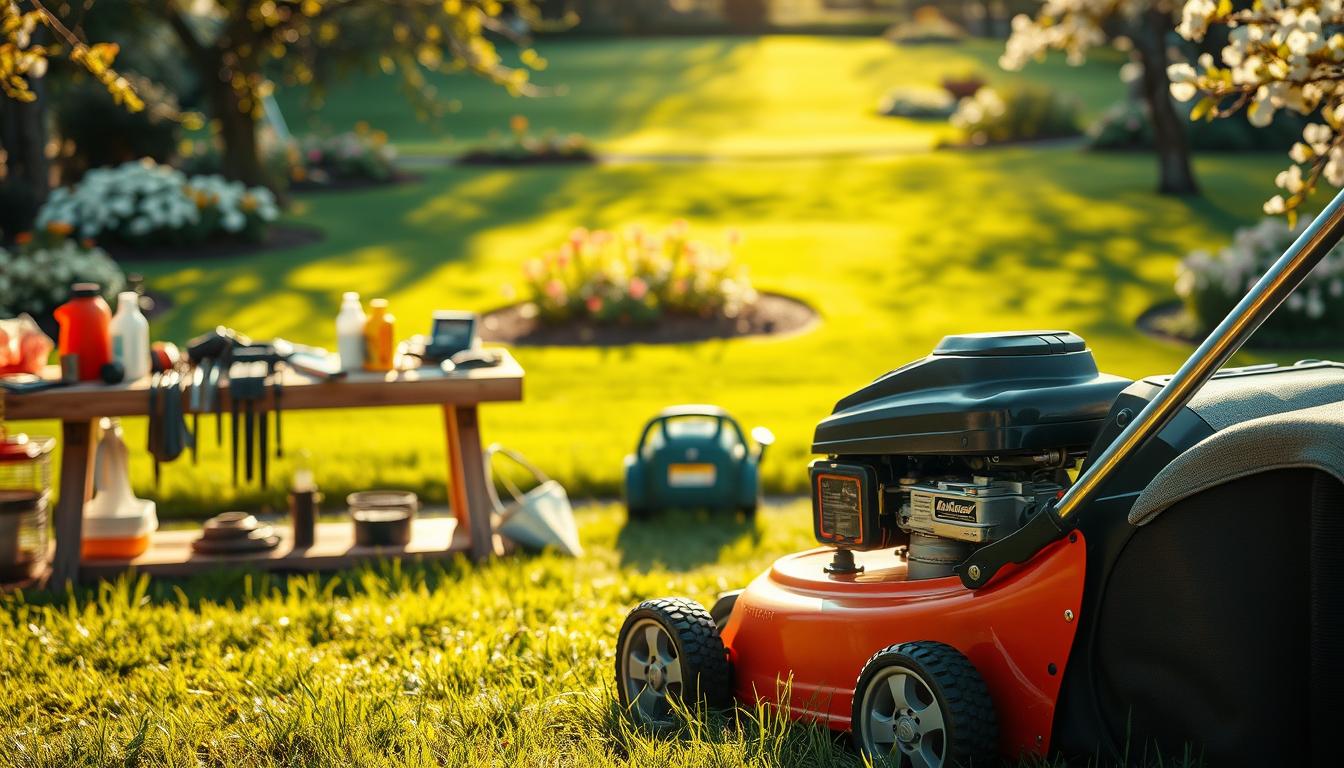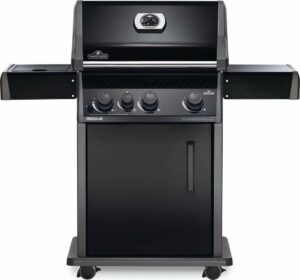Spring is coming, and it’s time to get your lawn mower ready. A good spring maintenance routine will make your mower work better and last longer. This guide will show you how to do a tune-up and other DIY tasks. Follow these tips to take care of your lawn with confidence this season.
Key Takeaways
- Clean the lawn mower engine to ensure it runs smoothly.
- Regularly change the engine oil and filters.
- Keep the lawn mower blade sharp and inspect for any damage.
- Clean the lawn mower deck to prevent rust and debris buildup.
- Grease the lubrication points to reduce wear and tear.
Clean the Lawn Mower Engine
Keeping your lawn mower in top shape is key. One crucial step is to keep the engine clean. This helps it last longer and work better.
Removing Debris from the Engine
First, disconnect the spark plug lead to prevent the mower from starting. Use a bristle brush to clean dirt from important parts like the flywheel fins and cooling fins. This is essential for good airflow and cooling.
Using a Degreaser for Greasy Areas
For tough grease spots, a degreaser works wonders. Spray it on, wait a few minutes, then wipe clean with a cloth. It makes your engine look great and run smoothly.
Referencing the Operator’s Manual
Always check your lawn mower’s manual for advice. It offers specific tips on engine care, including cleaning. Following the manual’s advice ensures you’re using the right methods for your mower.
Change the Lawn Mower Engine Oil and Filters
Keeping your lawn mower in top shape is key. Regular oil changes and air filter swaps are crucial. They help your mower run smoothly.
Engine Oil Change Process
Changing the engine oil is vital for your mower’s health. First, take off the oil drain plug and let the old oil flow into a container. After draining, put the plug back and fill the engine with the right oil type and amount, as your manual says. Fresh oil keeps engine parts lubricated and prevents overheating.

Importance of Air Filter Replacement
The air filter keeps dirt out of the engine. A clean filter is key for good engine performance and life. Check the air filter often and replace it if it’s dirty or damaged. Skipping this can hurt airflow and engine performance, making it a must for mower care.
Manufacturer’s Guidelines for Oil and Filters
Always follow the maker’s advice on oil and filter care. These guidelines tell you what oil to use, how much, and when to change it. Sticking to these rules helps your mower run well and last longer.
Sharpen the Lawn Mower Blade
Sharpening your lawn mower blade is key to a healthy lawn. Dull blades tear the grass, causing unhealthy lawns and more mowing. Sharp blades give a clean cut and vibrant, green grass.
Removing the Blade for Sharpening
To start, safely remove the blade as your manual instructs. Make sure the mower is off and the spark plug is out to avoid accidents. Use a wrench to unscrew the blade, noting its position for later.
Inspecting the Blade for Damage
After removing the blade, inspect it for wear. Look for nicks, dents, or bends. If it’s badly damaged, it’s time for a new blade. A sharp blade improves mower efficiency and lawn health.
Cleaning Under the Mower Deck
While the blade is out, clean under the mower deck. Grass clippings and debris can cause rust and lower performance. Use a brush or knife to remove the debris, making sure the deck is clean before putting the blade back.
| Steps | Action | Importance |
|---|---|---|
| 1 | Remove the blade | For safe and effective sharpening |
| 2 | Inspect the blade | Identify any damage and ensure quality |
| 3 | Clean under the mower deck | Prevent rust and improve mower performance |
Clean the Lawn Mower Deck
Keeping your mower in top shape means regular lawn mower deck cleaning. This is key during spring lawn care to clear out last season’s debris. It stops grass buildup and rust.

Why Deck Cleaning is Important
Regular lawn mower deck cleaning boosts your mower’s performance and life. A clean deck stops grass clippings and debris from causing rust. This leads to a better cut and less chance of lawn diseases.
Safety Precautions When Cleaning
When cleaning your lawn mower deck, safety first. Always turn off the mower to avoid start-ups. Use water and a putty knife to remove stuck debris. Then, apply wax to the deck to stop buildup. This keeps your mower running well.
Grease the Lawn Mower’s Lubrication Points
Proper mower lubrication is key for your lawn equipment’s smooth running and long life. Regular care is crucial for your mower’s performance all season long.
Identifying Lubrication Points
First, check your mower to find all the spots that need grease. Look at your mower’s manual to know where these areas are. Finding these spots right is important for good mower maintenance.
Using the Right Type of Grease
It’s important to use the grease your mower model needs. The right grease reduces wear and makes your mower run smoothly. Make sure to clean up any extra grease to avoid dirt problems. This step is essential for your mower’s efficiency and life.
Lawn Mower Spring Maintenance
Spring is the perfect time to get your lawn mower ready for the season. This comprehensive mower maintenance guide will help you keep your mower running smoothly. Here’s a detailed lawn mower checklist to get you started:
Comprehensive Maintenance Checklist
- Change the engine oil and replace filters.
- Sharpen and inspect the blade for any damage.
- Clean the mower deck thoroughly to prevent grass buildup.
- Check and grease all lubrication points.
- Inspect and charge the battery if needed.
- Inspect and replace spark plugs if necessary.
- Refer to the owner’s manual for specific maintenance procedures.
Tuning Up Your Lawn Mower
Doing a thorough tune-up is also important. Check the carburetor, ignition system, and make sure all bolts and screws are tight. Regular tune-ups can prevent breakdowns and extend your mower’s life.
Following this lawn mower spring maintenance routine will keep your mower in great shape. It makes lawn care easier and more fun.
Check the Lawn Mower Battery
Getting your lawn mower ready for the season begins with lawn mower battery maintenance. This is key for both electric and start-function mowers. A well-maintained battery ensures your mower starts up right and runs smoothly.
Inspecting Battery Health
A detailed battery health check is the first step in lawn mower battery care. Look for wear, corrosion, or damage. Check that connections are tight and terminals are clean. Fix any problems quickly to avoid more damage.
Charging and Replacing the Battery
Another important part of mower preparation is keeping the battery charged. If it can’t hold a charge anymore, it’s time for a new one. Charge the battery regularly to extend its life and keep it working well. Always follow the maker’s advice for battery care and replacement.
Here’s a quick guide to battery checks:
| Maintenance Task | Recommended Action |
|---|---|
| Visual Inspection | Check for wear, corrosion, or damage |
| Connection Check | Ensure terminals are clean and secure |
| Charging | Fully charge or replace if unable to hold charge |
Inspect and Replace Spark Plugs
Regular spark plug inspection is key for your mower engine’s health. It checks for wear or damage, ensuring your engine runs well.
Spark plugs are essential for starting and running the engine. They ignite the fuel-air mix. Over time, they can get clogged with carbon, causing issues like hard starts and poor fuel efficiency.
Importance of Spark Plugs in Engine Efficiency
Good spark plug inspection boosts mower engine efficiency. When spark plugs are in top shape, combustion is better. This leads to better fuel use and engine performance.
When to Replace Spark Plugs
You should replace spark plugs every year or as your mower manual says. Look out for signs like hard starts, misfires, or less engine power. Always check your mower’s manual for the right time to replace spark plugs.
Conclusion
As spring arrives, it’s key to make sure our lawn mowers are ready. Following this spring mower maintenance guide helps you prepare for mowing season. Tasks like cleaning the engine, changing the oil, sharpening the blade, and checking the battery are all important.
Doing these DIY tasks improves your mower’s performance and makes it last longer. Always check your mower’s manual for specific care and safety tips. This is crucial for keeping your mower in top shape and ensuring your safety.
Spending time on spring maintenance will make mowing easier all season. Make sure the battery is charged and replace old spark plugs. Every step you take helps keep your lawn looking great. Happy mowing!







